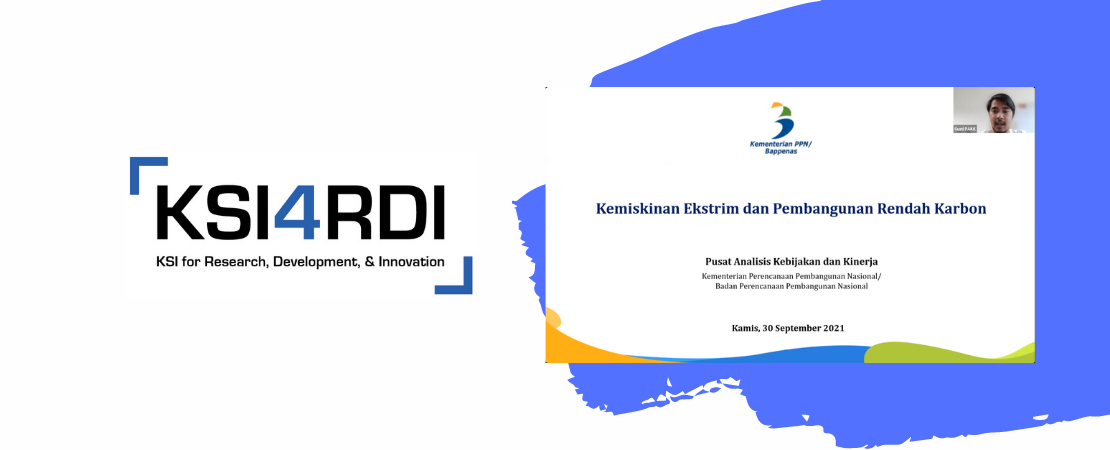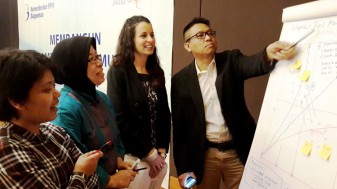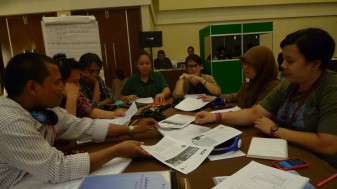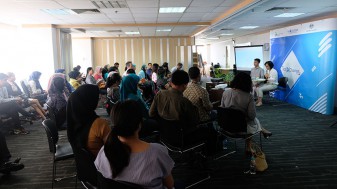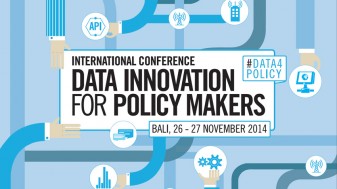Because of the pandemic, the extreme poverty level in Indonesia rose from 3.08 percent to 3.2 percent in 2020. Low carbon development is expected to reduce this extreme poverty rate.
This was one of the points in the series of discussions of KSI for Research, Development, and Innovation or KSI4RDI entitled “Chronic Poverty Cluster from the Aspects of Low Carbon Development and Social Protection” on Thursday (30/9). This event was held by the Center for Policy Analysis and Performance (PAKK) of the National Development Planning Agency (Bappenas), supported by the Knowledge Sector Initiative (KSI). Acting as resource persons for this online discussion was a Researcher from SMERU Research Institute, Mayang Rizky, and the Executive Director of Article 33 Indonesia, Santoso. This event was moderated by an Expert Staff of PAKK Bappenas, Gusti Raganata.
Low carbon development aims to sustain economic and social growth through low emission development activities that minimize natural resources exploitation. Bappenas is currently preparing a new platform for this development as a part of the green economy implementation.
SMERU Researcher, Mayang Rizky, explained that the extreme poverty rate in Indonesia has been relatively low compared to the national poverty rate, which is around 9 percent. From 1981 to 2019, the poverty rate trend continued to decrease. However, when the poverty level is lower, the poverty eradication rate becomes slower, due to increasingly complex issues to be resolved. When the pandemic hit, the poverty eradication rate continued to get slower, resulting in a spike in the extreme poverty rate.
She added that President Joko Widodo is targeting the eradication of extreme poverty by 2024. This vision is in line with one of the Sustainable Development Goals (SDGs), which is to end poverty in all its forms, everywhere. In this context, the government has launched a number of programs to erase extreme poverty, such as the Social Assistance Program for Nine Staple Needs (Sembako Program) and Family Hope Program or PKH. “It’s just that not all extremely poor groups receive this assistance. The local government units have also admitted to the challenges in updating the Social Welfare Integrated Data (DTKS),” said Mayang.
Based on the research on extreme poverty carried out by SMERU, from 2.8 million households in the extremely poor category according to DTKS, only 2.2 million of them received Sembako Program, and 1.9 million received PKH assistance. This means some assistances missed the target, and this may affect the extreme poverty eradication rate.
According to Mayang, special efforts need to be done to ensure the success of the agenda to eradicate extreme poverty by 2024. SMERU recommends expanding the scope of ongoing poverty eradication programs. The DTKS Data needs to be updated to reach extremely poor households yet to receive assistance. In addition, special and additional programs are required, such as assistance for people with disabilities and elderlies within extremely poor families.
In relation with extreme poverty reduction through the low carbon development program, some measures can be taken. The Executive Director of Article 33 Indonesia, Santoso, said that two examples are the Social Forestry Program (PPS) and economic diversification.
PPS is a program that grants the right for people living around forest areas to manage the forest. Through PPS, the number of forest encroachment will decrease, thus preventing deforestation as well as improving the welfare of people living around the forest. The result of Article 33’s research concludes that during 2010-2018, PPS had indeed improved the people’s welfare by 5.32 percent. However, the deforestation rate remains at 18 percent. “Deforestation is a long-term process and is influenced by a myriad of factors,” said Santoso.
Another endeavor is through economic diversification. This program is a reform effort so that a region does not depend on just one economic sector or has many sources for growth. With this, it is expected that exploitation of non-renewable natural resources can be reduced, and at the same time promoting a shift of the economic sector to be more environmentally friendly or sustainable.
Santoso thinks that economic diversification can bring prosperity. But this takes time. Even in the short term, some costs need to be covered, including adjustment costs for sector reallocation. A region that was initially focused on coals and wanted to go into the tourism or plantation sector, for example, needs to invest cost to enter the new sector. “Diversification is not a popular policy in terms of political economy, despite local governments’ warm welcome. This is an uncomfortable policy,” he said.
A researcher from Article 33, Sandy Maulana, added that based on Article 33’s research, so far there is no evidence that a communal or group-based program like PPS and economic diversification is able to improve the welfare of extremely poor groups. This is because in many cases, extremely poor groups serve only as viewers, and are not involved in decision making. The government needs to make policies that target individuals, not just intervening in their communities.
Based on perspective enrichment and elaboration by the above-mentioned SMERU and Article 33’s researchers, PAKK Bappenas will develop a policy brief on low carbon development that has an impact on extreme poverty eradication. This policy brief is expected to provide inputs and recommendations on strategic aspects of low carbon development for reducing extreme poverty to relevant leaders and stakeholders.
KSI4RDI (KSI for Research, Development, and Innovation) is a platform to convene and expand the institutional network among the knowledge sectors in Indonesia, especially in research, development, and innovation. KSI4RDI’s series of discussions are expected to facilitate interaction and collaboration among knowledge producers and policymakers to support the knowledge-to-policy process. This particular KSI4RDI series discussion was intended to support the role of PAKK Bappenas in providing knowledge-based policy inputs and recommendations. This information exchange is expected to enrich and sharpen the analysis output to be responsive to the policy formulation needs.

